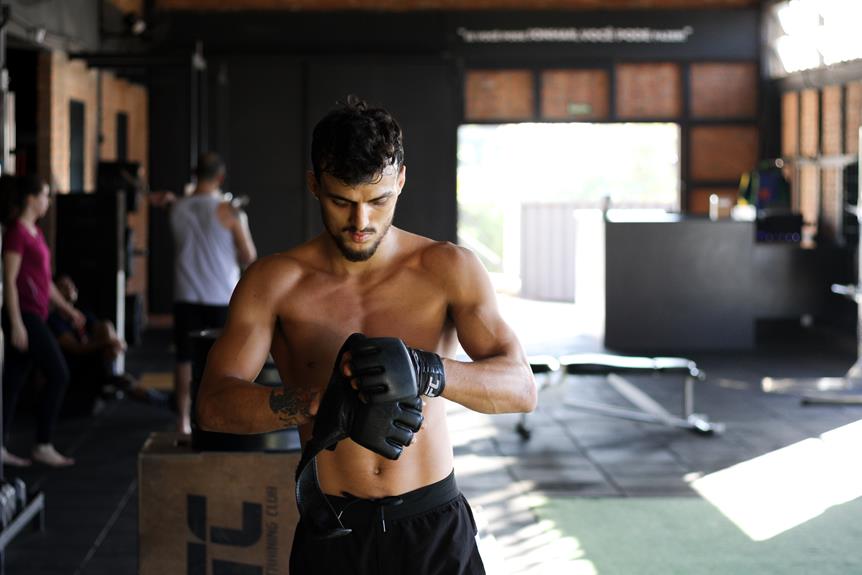Have you ever wondered about the intricacies of the elusive Ezekiel choke submission in MMA and Bjj? Look no further, as this article dives deep into the technical aspects and historical origins of this highly effective grappling technique.
From its various types and effects to its execution in both gi and no-gi scenarios, this comprehensive guide will equip you with the knowledge and skills necessary to master the art of the Ezekiel choke.
Prepare to enhance your repertoire and dominate the mat with this formidable submission hold.
Key Takeaways
- The Ezekiel choke is a judo/Bjj technique used to choke and cut off blood flow to the brain.
- It involves threading an arm around the back of the opponent's head and using the other hand/forearm across the neck.
- The choke can be secured from both top and bottom positions and has various variations based on hand/wrist/forearm placement.
- The main intention of the Ezekiel choke is to be a blood choke, but if not executed perfectly, it can become an air choke causing pain instead of inducing sleep.
Basics of the Ezekiel Choke
The basics of the Ezekiel choke involve utilizing a specific technique to apply pressure on the opponent's neck, cutting off blood flow and inducing a chokehold. This highly effective submission in MMA and BJJ has various variations, allowing for different placements of the hand, wrist, and forearm.
One of the common mistakes in executing the choke is improper hand placement, which can result in an air choke rather than a blood choke. It is crucial to ensure that the technique is performed with precision and accuracy to maximize its effectiveness.
Types and Effects of the Choke
An ezekiel choke submission is a highly effective blood choke that constricts the carotid arteries, cutting off the oxygen-rich blood supply to the brain. This technique is known for its effectiveness in Brazilian jiu-jitsu and Gracie jiu-jitsu.
The advantages of the ezekiel choke lie in its ability to quickly incapacitate an opponent by inducing unconsciousness. It can be executed from various positions, making it a versatile technique.
However, there are also disadvantages to consider. One common mistake in executing the ezekiel choke is applying too much pressure on the windpipe instead of the carotid arteries, resulting in an air choke that causes pain instead of inducing sleep. Another mistake is not securing the grip properly, which can result in the opponent escaping or countering the choke.
Mastery of the ezekiel choke requires precision and proper technique execution to maximize its effectiveness.
History and Origins of the Technique
The history and origins of the ezekiel choke technique can be traced back to its original use in judo with a gi. Known as sode guruma jime in Japanese, it was introduced without a gi in MMA approximately 30 years ago. The exact inventor of the ezekiel choke is unknown, but it is believed to have been developed by Kano Jigoro, the founder of judo.
The technique gained popularity when Ezequiel Paraguassu, a judoka from Carlson Gracie's gym, used it in 1988 and gave it the name 'ezekiel choke'. Over time, the technique evolved and became widely incorporated in Brazilian jiu-jitsu and Gracie jiu-jitsu due to its effectiveness.
Today, the ezekiel choke continues to be a highly effective submission technique in MMA and BJJ.
Techniques and Variations of the Choke
Exploring the techniques and variations of the choke, practitioners utilize various grips and placements to execute the ezekiel choke submission in MMA and BJJ.
When it comes to Ezekiel choke setups, there are different approaches depending on whether it is performed with or without a gi (no gi vs gi variations).
Here are some key variations:
No Gi Variations:
- Thread the right arm around the back of the opponent's head and grab the left bicep.
- Drive the left fist into the opponent's neck off-center to the left side.
- Grab the left bicep instead of the forearm/wrist.
- Grab the left forearm and place the fist on the opponent's Adam's apple while arching backward.
Gi Variations:
- Same as the no-gi variation #1, but grip the left sleeve with four fingers.
- Secure the choke from the top position in closed guard by reaching around the opponent's head and driving the left forearm into the neck.
- Secure the choke from the back by threading the right arm under the opponent's armpit and placing four fingers into your left sleeve over their left shoulder.
Defense Against the Ezekiel Choke
When countering the Ezekiel choke, practitioners must employ effective defensive strategies to neutralize the opponent's submission attempt.
One common mistake in defending the Ezekiel choke is failing to recognize the setup and allowing the opponent to establish a dominant position. It is crucial to maintain proper posture and hand placement to prevent the opponent from threading their arm around the back of the head.
Another mistake is not reacting quickly enough when caught in the choke. Immediate action is necessary to create space and relieve pressure on the neck. This can be done by explosively bridging or bumping the opponent forward, while simultaneously threading the arm upwards on the front side of the neck.
Notable Examples in MMA History
There have been several notable examples of the Ezekiel choke submission in MMA history. This highly effective yet underrated submission has provided some of the most memorable moments in the sport. Let's take a look at some famous fighters who have successfully utilized the Ezekiel choke in their fights:
- Hidehiko Yoshida vs Kiyoshi Tamura at Pride FC Total Elimination 2003: Yoshida showcased the effectiveness of the Ezekiel choke with a submission victory over Tamura in this highly anticipated matchup.
- Aleksei Oleinik vs Viktor Pesta at UFC FN:103: Oleinik, known for his mastery of the Ezekiel choke, secured another impressive victory using this technique in the UFC.
- Aleksei Oleinik vs Junior Albini at UFC 224: Once again, Oleinik demonstrated his expertise by finishing Albini with the Ezekiel choke.
With 14 Ezekiel choke submissions out of his 47 submission wins, Aleksei Oleinik has established himself as one of the best practitioners of this technique in MMA history.
These fighters have shown the power and effectiveness of the Ezekiel choke, solidifying its place as a formidable submission in the world of mixed martial arts.
Frequently Asked Questions
Are There Any Legal Restrictions or Rules Regarding the Use of the Ezekiel Choke in MMA or BJJ Competitions?
Legal restrictions and rules vary in MMA and BJJ competitions regarding the use of the Ezekiel choke. Safety concerns are taken into consideration, and organizations may have specific guidelines to ensure the well-being of participants.
Can the Ezekiel Choke Be Used as a Self-Defense Technique Outside of the MMA or BJJ Context?
The Ezekiel choke can be an effective self-defense technique outside of MMA/Bjj. With its ability to cut off blood flow to the brain, it can quickly incapacitate an attacker. However, there are alternative choke techniques that may be more practical in real-life situations.
Are There Any Specific Training Drills or Exercises That Can Help Improve the Effectiveness of the Ezekiel Choke?
Training exercises and drills that can enhance the effectiveness of the ezekiel choke include grip strengthening exercises, positional drills to improve body control, and partner drills focusing on proper hand placement and pressure application. These exercises can help refine technique and increase proficiency in executing the choke.
What Are the Potential Risks or Dangers Associated With Attempting the Ezekiel Choke, Both for the Person Applying the Choke and the Person Being Choked?
The potential risks and dangers associated with attempting the Ezekiel choke in MMA/BJJ include injury to the windpipe or voice box, as well as the risk of unconsciousness. Legal restrictions and rules on the use of the choke vary in different competitions.
Are There Any Common Mistakes or Misconceptions That People Often Make When Attempting to Apply the Ezekiel Choke?
Common mistakes and misconceptions when applying the Ezekiel choke include improper positioning and hand placement. It is crucial to have precise arm placement around the opponent's head and a secure grip across the neck to execute the choke effectively.
Conclusion
In conclusion, the ezekiel choke submission is a highly effective technique utilized in MMA and BJJ. Its strategic positioning and application of pressure on the opponent's neck restrict blood flow and can lead to a successful submission.
However, proper execution and understanding of this technique are crucial to avoid potential dangers such as an air choke. With its rich history, various types and variations, and notable examples in MMA, the ezekiel choke remains a formidable and exciting maneuver in combat sports.
Like a well-timed strike, it can swiftly bring an opponent to their knees.
- 15 Best Martial Arts Weapons (Fighting & Training) - October 14, 2024
- Is Fencing a Martial Art? (Yes, 4 Reasons Why) - October 14, 2024
- 7 Best Martial Arts for Self-defense Ranked (Highly Effective) - October 14, 2024










